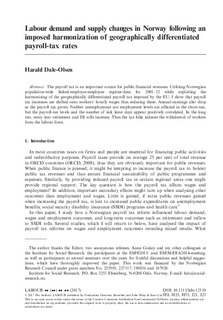Labour demand and supply changes in Norway following an imposed harmonization of geographically differentiated payroll-tax rates
| dc.contributor.author | Dale-Olsen, Harald | |
| dc.date.accessioned | 2018-01-05T07:51:23Z | |
| dc.date.available | 2018-01-05T07:51:23Z | |
| dc.date.created | 2018-01-04T10:40:15Z | |
| dc.date.issued | 2017 | |
| dc.identifier.issn | 1121-7081 | |
| dc.identifier.uri | http://hdl.handle.net/11250/2475850 | |
| dc.description.abstract | The payroll tax is an important source for public financial revenues. Utilizing Norwegian population-wide linked-employer-employee register-data for 2001–12 while exploiting the harmonizing of the geographically differentiated payroll tax imposed by the EU, I show that payroll tax increases are shifted onto workers’ hourly wages thus reducing these. Annual earnings also drop as the payroll tax grows. Neither unemployment nor employment levels are affected in the short-run, but the payroll-tax levels and the number of sick leave days appear positively correlated. In the long run, entry into retirement and DI rolls increase. Thus the tax hike induces the withdrawal of workers from the labour force. | en |
| dc.language.iso | eng | |
| dc.title | Labour demand and supply changes in Norway following an imposed harmonization of geographically differentiated payroll-tax rates | |
| dc.type | Peer reviewed | |
| dc.type | Journal article | |
| dc.description.version | publishedVersion | |
| dc.source.journal | Labour | |
| dc.identifier.doi | 10.1111/labr.12119 | |
| dc.identifier.cristin | 1535550 | |
| cristin.unitcode | 7437,0,0,0 | |
| cristin.unitname | Institutt for samfunnsforskning | |
| cristin.ispublished | true | |
| cristin.fulltext | original | |
| cristin.fulltext | ||
| cristin.fulltext | ||
| cristin.fulltext | description.abstract | |
| cristin.fulltext | ||
| cristin.qualitycode | 1 |
Tilhørende fil(er)
Denne innførselen finnes i følgende samling(er)
-
Publikasjoner fra CRIStin [708]
-
Tidsskriftpublikasjon [386]
Artikkel i tidsskrift
